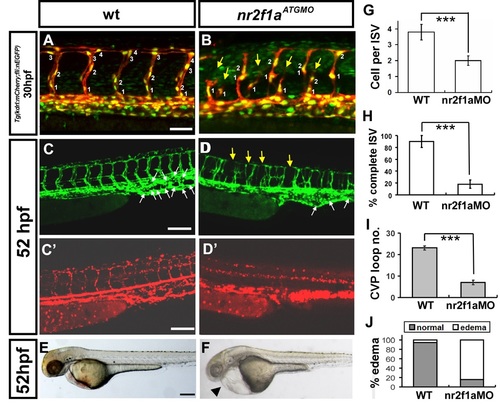Fig. S2
- ID
- ZDB-FIG-150204-628
- Publication
- Wu et al., 2014 - Nuclear Receptor Subfamily 2 Group F Member 1a (nr2f1a) Is Required for Vascular Development in Zebrafish
- Other Figures
- All Figure Page
- Back to All Figure Page
|
Knockdown of nr2f1a causes defects in vascular development in zebrafish by using translational block ATG morpholino (A-D) Loss of nr2f1a showed ISV growth defect (yellow arrows in B and D) and mis-pattern plexus at CVP (caudal vein plexus) (white arrows in D) at 30hpf and 52hpf. At 30 hpf, in uninjected control embryos, intersegmental vessels (ISV) have reached the DLAV of the embryo (A) and caudal vein plexus were formed honeycomb-like structures at the tail (white arrows in C). At the same stage ISVs are stalled mid-somite in nr2f1aATG morphants (B, D). (G) The number of cells forming each ISV were counted from wild type control Tg(kdrl:mCherry; fli1a:negfp)y7 and nr2f1a morphant embryos at 30 hpf, showing a significant decrease in nr2f1a morphant. (H) Quantification of percentage of completed ISV shows a ~70% increase compare to nr2f1a ATG morphants (n=24 in wt and n=20 in nr2f1aMO) at 30 hpf. (I) Quantification of loop formation at CVP at 48-52hpf shows a ~4-fold decreased in nr2f1a morphants (n=8 in wt and n=12 in nr2f1aMO). In addition, loss of nr2f1a results in circulation defects (blood stock at vessel/CVP or no circulation at ISV/DLAV region) (D′) and pericardial edema (arrowhead in F) shown at 52hpf. (J) Quantitative results showed ~80% of nr2f1a morphants (n=18) with pericardial edema compared to wt (n=20). (*** refers to p< 0.0001 by an unpaired student′s t-test. Scale bars are 50 Ám for A-B, 100 mm for C-D, C′-D′, and 200 Ám for E-F. |
| Fish: | |
|---|---|
| Knockdown Reagent: | |
| Observed In: | |
| Stage Range: | Prim-15 to Long-pec |

